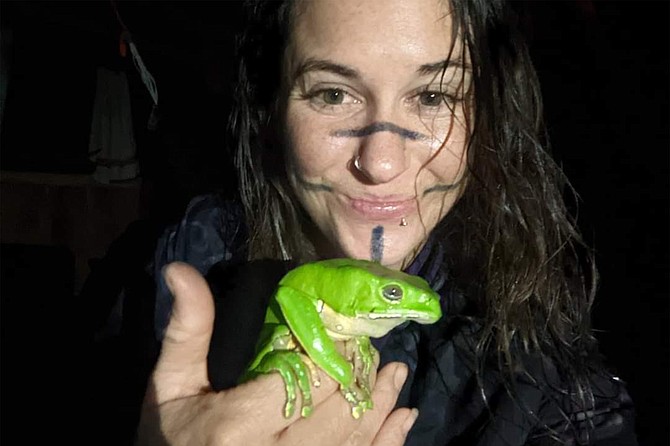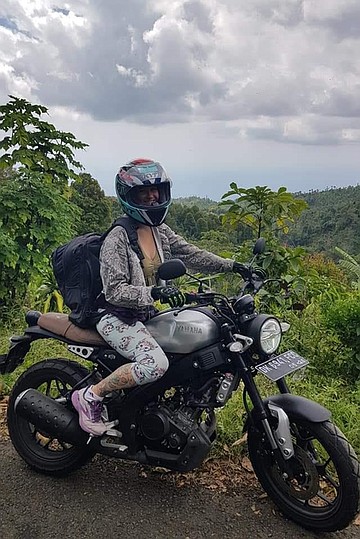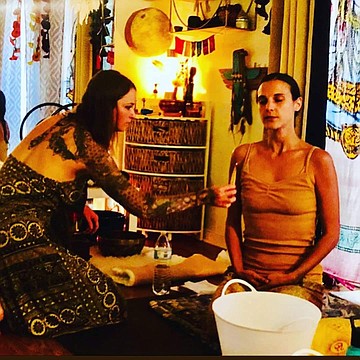 Facebook
Facebook
 X
X
 Instagram
Instagram
 TikTok
TikTok
 Youtube
Youtube

It was about a decade ago, in the jungle city of Iquitos, Peru, that Caitlin Thompson first heard about Kambo, a traditional medicine used by some indigenous groups in the Amazon. Kambo is the poisonous secretion of the giant leaf frog or giant monkey frog (phyllomedusa bicolor), which is applied with a stick to superficial burns that have been inflicted on the patient so that the stuff may enter the bloodstream.
The wider world first learned about Kambo decades ago through the work of the journalist and explorer Peter Gorman; he was introduced to it by the Matses people, who have used it for hundreds of years as a general tonic, a treatment for malaria and snakebite, and a preparation for hunting and war. Lately, however, its use been growing in popularity all over the globe.

Kambo involves effects that are powerful and formidable-sounding, even if they are short-lived. Common ones include hard and fast heartbeats, skin flushing, facial swelling, faintness, pressure in the head, bowel movements, and, probably most famously, vomiting. Understandably, Thompson was not immediately drawn to it. To be precise, she says, “I heard about it and I was like, ‘That shit sounds crazy.’”
Still, what she heard in Iquitos piqued her interest enough to send her onto the internet after she arrived home for a look into the matter. She was intrigued by one study she found about some of the chemical makeup of the substance. She thought, “Oh, there’s actually some science on this. Which I found interesting.” She learned about some of the peptides in Kambo — some that are opioids, some that lower blood pressure — but afterwards, she says, she just stopped thinking about it. That is, until her close friend Edward Deull came over one day and told her that he had been “going deep with this frog medicine lately.” She liked and trusted Deull, and was disposed to listen with an open mind when he began to talk about what he was getting out of his experiences. Before that, “no one had ever told me about why you’d want to do it.” So she hadn’t heard about the positive, non-vomitous side of Kambo: the relief of physical pain, the mental clarity and courage that devotees report. Before, “it just sounded crazy and dangerous and awful.” But now, her trusted friend was serving as an envoy from the Kambo world, and through him, she took the opportunity to give it a try — in someone’s home out in the desert.
“It was during that first Kambo experience where I started to rapidly heal,” Thompson says. After many years of dealing with a wide variety of autoimmune, digestive, and mood problems — she provided a list of around a dozen conditions that she summarizes as “just a lot of words to describe someone who is, overall, not well” — she experienced, first, “a complete abolishment” of pain. The experience highlighted for her just how bad she had been feeling for so long. That was followed by the firm sense that the origins of her problems were “psycho-spiritual.” She felt a new awareness that they extended beyond her, backwards into generations of her family, and perhaps most importantly, that she could be freed from them. The revelation: “This isn’t yours. You don’t have to carry it. You don’t have to attack yourself.”
“I guess I’m all-in on this frog thing,” she realized.
After she finished up her sessions in the desert, Deull taught Thompson to self-administer. Soon she started working on friends, then strangers who heard about it. “Next thing I knew, I fell into being a practitioner.” She decided it would be good to get some more formal training, and sought it through the International Association of Kambo Practitioners. “Once I came back from the training,” she recalls, “it exploded, and it never slowed down until I literally left the country and hid from it during the pandemic.” Here she is referring to her self-imposed exile in Bali over the last two years. Before that, she was conducting up to 400 sessions a year, which took a toll on her. But she never really felt that she could just walk away from it, or that she could do something easier. Thompson feels that she is in a deal, or “spiritual contract,” with Kambo. She says, “This medicine is like, ‘Hey I can be here to give you a vibrant chance at health, and sustainable income, and purposeful work, and you can help people, and help your family and your animals and your friends, but you work for me.”

And the deal is not an easy one to keep, whether she is the facilitator or the participant. “I’ve got to be honest: I don’t want to keep burning myself and doing Kambo. It’s uncomfortable. I’d like to just be healed and be over it.” Yet, she says, “for me, it’s an integral part of my life, and it’s a medicine that continues to save my ass. This medicine has saved my life. It has given me life.” Further, she still finds it deeply gratifying to bring this experience to other people, in whom she sees what she calls “miracle after miracle.” She says she has a special interest in working with people who, like her, have dealt with chronic health problems.
When we met, Thompson had been back in San Diego for only a week, and was sporting lots of new tattoos, acquired in Bali for her 30th birthday. The new adornment included several representing in molecular form the “chemical allies to my healing process: nutrients, love, botanicals, endogenous neurotransmitters, synthetic psychedelics, plant-based psychedelics. Then I have some of the peptides from the frog on my leg.” Her right arm features a large Ganesha — the elephant-headed Hindu remover of obstacles — intricate geometric patterns, and a likeness of her beloved late dog’s eyes.
She’s busy now looking for a new home, one that will also serve as the setting for her Kambo work. And soon, she will be off on a journey to the jungle again, as she brings her first group of American practitioners on a Kambo retreat with some of the Matses friends she has made in Peru.


It was about a decade ago, in the jungle city of Iquitos, Peru, that Caitlin Thompson first heard about Kambo, a traditional medicine used by some indigenous groups in the Amazon. Kambo is the poisonous secretion of the giant leaf frog or giant monkey frog (phyllomedusa bicolor), which is applied with a stick to superficial burns that have been inflicted on the patient so that the stuff may enter the bloodstream.
The wider world first learned about Kambo decades ago through the work of the journalist and explorer Peter Gorman; he was introduced to it by the Matses people, who have used it for hundreds of years as a general tonic, a treatment for malaria and snakebite, and a preparation for hunting and war. Lately, however, its use been growing in popularity all over the globe.

Kambo involves effects that are powerful and formidable-sounding, even if they are short-lived. Common ones include hard and fast heartbeats, skin flushing, facial swelling, faintness, pressure in the head, bowel movements, and, probably most famously, vomiting. Understandably, Thompson was not immediately drawn to it. To be precise, she says, “I heard about it and I was like, ‘That shit sounds crazy.’”
Still, what she heard in Iquitos piqued her interest enough to send her onto the internet after she arrived home for a look into the matter. She was intrigued by one study she found about some of the chemical makeup of the substance. She thought, “Oh, there’s actually some science on this. Which I found interesting.” She learned about some of the peptides in Kambo — some that are opioids, some that lower blood pressure — but afterwards, she says, she just stopped thinking about it. That is, until her close friend Edward Deull came over one day and told her that he had been “going deep with this frog medicine lately.” She liked and trusted Deull, and was disposed to listen with an open mind when he began to talk about what he was getting out of his experiences. Before that, “no one had ever told me about why you’d want to do it.” So she hadn’t heard about the positive, non-vomitous side of Kambo: the relief of physical pain, the mental clarity and courage that devotees report. Before, “it just sounded crazy and dangerous and awful.” But now, her trusted friend was serving as an envoy from the Kambo world, and through him, she took the opportunity to give it a try — in someone’s home out in the desert.
“It was during that first Kambo experience where I started to rapidly heal,” Thompson says. After many years of dealing with a wide variety of autoimmune, digestive, and mood problems — she provided a list of around a dozen conditions that she summarizes as “just a lot of words to describe someone who is, overall, not well” — she experienced, first, “a complete abolishment” of pain. The experience highlighted for her just how bad she had been feeling for so long. That was followed by the firm sense that the origins of her problems were “psycho-spiritual.” She felt a new awareness that they extended beyond her, backwards into generations of her family, and perhaps most importantly, that she could be freed from them. The revelation: “This isn’t yours. You don’t have to carry it. You don’t have to attack yourself.”
“I guess I’m all-in on this frog thing,” she realized.
After she finished up her sessions in the desert, Deull taught Thompson to self-administer. Soon she started working on friends, then strangers who heard about it. “Next thing I knew, I fell into being a practitioner.” She decided it would be good to get some more formal training, and sought it through the International Association of Kambo Practitioners. “Once I came back from the training,” she recalls, “it exploded, and it never slowed down until I literally left the country and hid from it during the pandemic.” Here she is referring to her self-imposed exile in Bali over the last two years. Before that, she was conducting up to 400 sessions a year, which took a toll on her. But she never really felt that she could just walk away from it, or that she could do something easier. Thompson feels that she is in a deal, or “spiritual contract,” with Kambo. She says, “This medicine is like, ‘Hey I can be here to give you a vibrant chance at health, and sustainable income, and purposeful work, and you can help people, and help your family and your animals and your friends, but you work for me.”

And the deal is not an easy one to keep, whether she is the facilitator or the participant. “I’ve got to be honest: I don’t want to keep burning myself and doing Kambo. It’s uncomfortable. I’d like to just be healed and be over it.” Yet, she says, “for me, it’s an integral part of my life, and it’s a medicine that continues to save my ass. This medicine has saved my life. It has given me life.” Further, she still finds it deeply gratifying to bring this experience to other people, in whom she sees what she calls “miracle after miracle.” She says she has a special interest in working with people who, like her, have dealt with chronic health problems.
When we met, Thompson had been back in San Diego for only a week, and was sporting lots of new tattoos, acquired in Bali for her 30th birthday. The new adornment included several representing in molecular form the “chemical allies to my healing process: nutrients, love, botanicals, endogenous neurotransmitters, synthetic psychedelics, plant-based psychedelics. Then I have some of the peptides from the frog on my leg.” Her right arm features a large Ganesha — the elephant-headed Hindu remover of obstacles — intricate geometric patterns, and a likeness of her beloved late dog’s eyes.
She’s busy now looking for a new home, one that will also serve as the setting for her Kambo work. And soon, she will be off on a journey to the jungle again, as she brings her first group of American practitioners on a Kambo retreat with some of the Matses friends she has made in Peru.
Comments